Existing User Log In
New User Registration
Register for a free account to gain full access to the VGChartz Network and join our thriving community.



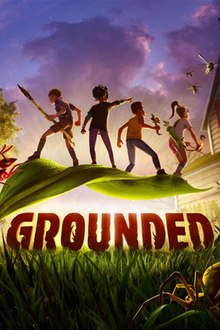

America - Front
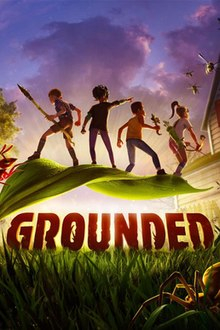

America - Back

Obsidian Entertainment
Action-Adventure
 (Add Date)
(Add Date) (Add Date)
(Add Date) (Add Date)
(Add Date)
| Owners: | 0 |
| Favorite: | 0 |
| Tracked: | 0 |
| Wishlist: | 0 |
| Now Playing: | 0 |
Obsidian's latest game has loads of bugs. Surprise, right? It’s tough to keep track of them all, really. You have aphids, ants, stinkbugs, and… well, the list goes on for miles! This dumb little misdirection emphasizes a point many are all too familiar with from this studio: wild ambition and intricate storylines typically saddled with haphazard technical execution. With what is effectively its first post-acquisition title under Microsoft, those expectations are being challenged by hopping to the survival genre. The intention is to aim small, both in setting and comparative design goals. With that in mind, where does Grounded rank on this food chain?
After selecting between one of four preset characters (Max, Willow, Pete, or Hoops), you wake up from a drugged stupor. Your cozy action figure casket is mysteriously open and the surrounding dirt walls invite you to the surface. Crawling out of this tunnel and into the bright sky reveals blades of grass standing three stories high and harmless aphids the size of a large dog. You've shrunken to the size of a worker ant without any recollection of how you wound up in this now-hostile backyard.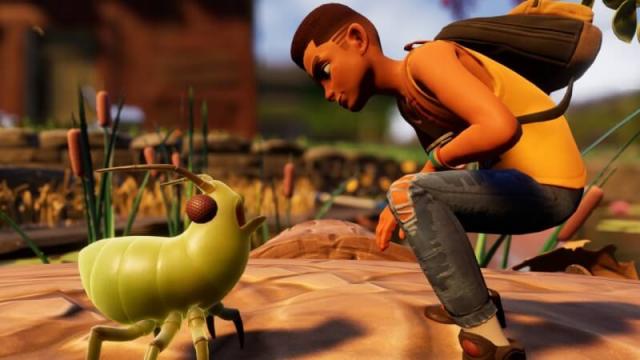
Scary as the situation may be, you still have to tough it out. The survival & crafting systems begin like usual: find and collect the most basic nearby elements, examine each item for potential new recipes, and smash stuff together for necessary tools. Continuing this cycle eventually leads to learning more about the wider world and incrementally improving your equipment and yourself. It's a particular rhythm that requires you to branch out and take on a number of different hazards, deadly creatures most notably, while concurrently managing your thirst & hunger meters.
What makes these otherwise unoriginal systems work is the Honey, I Shrunk The Kids premise. One of the first unique landmarks guided by the tutorial is the Mysterious Machine. A simple hole on its side reveals all the neat interior doodads – circuit boards, power converters, and so on. Your character's diminished weight is barely enough to push the machine's power button. Several insect howls sound strident and demonic at this height compared to when you'd squish them with your shoe. Similar to Stray, a dramatic shift in scale reshapes your view of these otherwise-routine mechanics.
This sensation catenates to combat and survival as well. Rather than buffing up your armor from grass, leather, and then metal, you're weighing grass armor and then various insect permutations. Instead of blacksmithing, it's about hollowing out an ant's exoskeleton and repurposed as a club or shoulder pads. Early on, you'll internalize the drawbacks of standing water and keeping an eye on dewdrops hanging from scattered grass blades. It's those consistent little details that make the world so believable.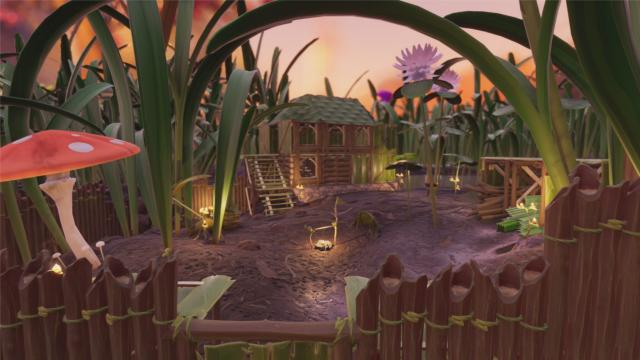
It'd be great if those nuances were properly built-up, however. In the abstract, I can respect the hands-off approach during parts of the extended tutorial. That said, there's a difference between emphasizing heuristic discoveries and a desultory structure. Grounded's beginning rides that nettlesome, confusing line; you're given information on certain basics but also risk greeting a two-hit kill enemy shortly off the beaten path. Those issues hit especially true for one of the first labs (main objective) because of its lackluster signposting and a nonsensical jump in enemy toughness and numbers. I intuit Obsidian's rationale of easing away the guardrails, but that portion was a rough slog.
Remembering that critical lab also highlights the unimpressive melee combat. The basic attack/block/parry system tied to stamina serves as... passable on principle, but it's rarely engaging in execution. Questionable hit registration for or against your favor, lackluster sound design doesn't carry much oomph! upon impact, and floaty locomotion outweigh the plurality of cool options with elemental buffs. Beyond that, the biggest frustration is successful enemy hits despite clipping through the geometry, especially when so weak to start. There may be fun boss scenarios, and ranged fighting fares better, but this common foundation for survival games is still such a tough personal hurdle.
These two crucial components after the prologue (in all but name) blunted my initial excitement. There's something about its mismanaged tempo while hoofing it alone that I couldn't shake. Altering the default difficulty is an option, but you expect the promise of its 'Medium' challenge to balance proportionally between one or multiple players. I didn't want to feel like I was skating through either. I was caught in a bind since the languor from spinning my wheels started getting the better of me, almost to the point of outright quitting. Knowing what I know now, I can't imagine tackling later bouts (especially bosses) without burning so much time for incrementally improved gear. 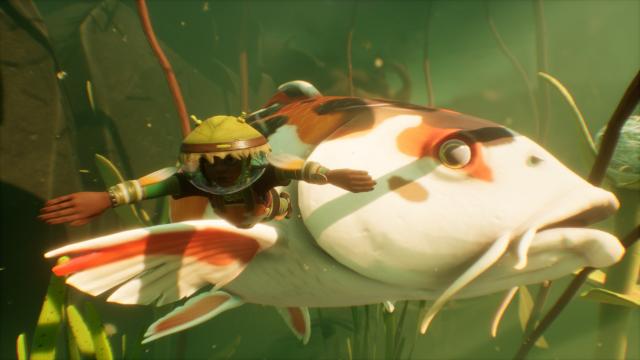
That outlook seems harsh, but those criticisms were indescribably easier to shoulder once I joined an online co-op crew. Once that particular lab was complete and the world expanded further, my enthusiasm was revitalized. With friends, the heightened comradery makes it easier to split up survival tasks, properly manage food & water levels, find critical shortcuts, or map out other necessary items needed to reach each new lab. It finds a cleaner rhythm of mixing open-ended play and subdued puzzle-solving to reach these areas.
While still a better time on the whole, Grounded comfortably falls into some of the usual survival trappings. Rather than heading straight towards each main objective, you'll have to invest a lot of time scavenging for supplies and building up bases. It's not my favorite feedback loop, but a few tweaks here keep it interesting. Some busywork is streamlined, such as not requiring all crafting equipment in your personal inventory within a base’s vicinity. The building layouts are also impressively expansive in options and concise in function. It's not here to rethink the genre but rather inject a special personality and a bit more polish; that said, specific qualms like annoying inventory limitations show there's room for more quality-of-life improvements.
That emphasis extends to the foundation as well: sprucing up the genre rather than being a thorough remodel. By enabling a freeform way of navigating the main story (especially with friends), you're tackling the world as you wish, uncovering fun secrets that can lead to permanent stat buffs, building the most glorious fortress capable of withstanding assaults, and so on. Not all is perfect – far from it! – but the way it marries scale, setting, and design ethos does enough to outweigh the negatives.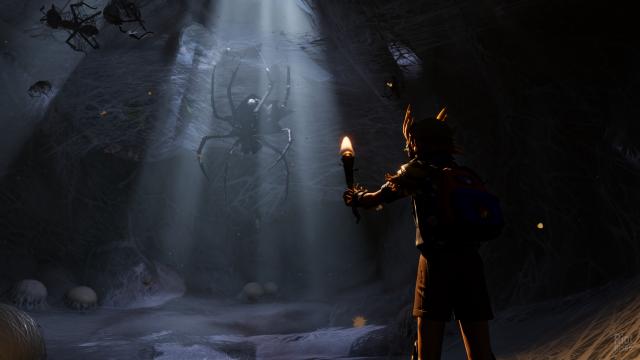
While not to the pedigree of Obsidian's past work, storytelling is another nice compliment to compel you forward. Similar to its direct inspiration, these plucky teenagers have to keep their wits while uncovering how they can return to normal size. Where it diverges is the mystery around why and how these events occurred. Aside from sporadic dream sequences and simplistic dialogue exchanges (often with the handsomely-moustached robot assistant BURG.L), collectibles and environmental storytelling bare the heaviest burden.
For what it may lack in quantity it makes up for in presentation. The semi-cartoony visual design between the world, characters, and insects capture an Amblin-esque nostalgia. Taking place in 1990, Dr. Tully's backyard is practically a treasure trove of that era: ascending a tall rock thanks to a discarded cassette tape, superhero-themed juice boxes with slurpable droplets on the ground, and so on and so on. Even though the world design and some of Justin E. Bell's soundtrack lean into 80s-era trappings, it's nice to see it handled with some restraint. Going too far would distract from an otherwise ordinary backyard transforming into a wonderfully diverse fantasy realm.
The main drawback to this fun yarn is how I wish there was more to drink in. Sure, listening to Dr. Tully's incisive exposition (enthusiastically voiced by Zachary Levi) in audio logs was always worthwhile, but there's not much to the playable characters aside from repetitive audio barks. This sensation of missing something extends to story and game design disconnectedness too. They intersect at spurts – having to earn the good ending for example, but more often they feel like oil and water: two elements disinterested in coalescing. With all that said, I'm sympathetic to the modest size of this game's team. Perhaps some of my wishes are too big of a burden for its humbler intentions, but it's tough to shake that missed potential.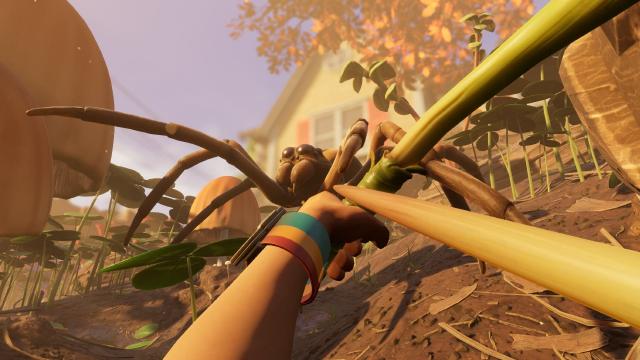
If a casually-incorporated narrative doesn't hold much sway compared to mechanics, then you'll likely appreciate its sizable value. As with most survival games, it's safe to expect countless hours managing all of your potential homesteads, uncovering new wildlife tucked away at different locales, conquering these landscapes, and crafting a surfeit of different recipes, armor sets, and trinkets. But there's a hang-up when it comes to the quality of your time: bugs of the technical variety. From host disconnects to giant enemies clipping into bases, there are a fair number of annoyances that the latest version (1.0.4) hasn’t handled. I don't want to go so far as to say these multitudinous issues severely impinged my overall experience, but they cropped up enough to pester me.
Like its intrepid adventurers, Grounded's still saddled with some growing pains. The opening hours (especially going solo) feel unnecessarily antagonistic and a repetitive chore to push forward, yet getting past that hurdle with co-op partners leads to greener pastures. Through that lens, I see this as a surefire thumbs-up for ardent genre fans. But when evaluating beyond its glimmering positives, taken on its own at this current state, various flaws shrink my enthusiasm.
Contractor by trade and writer by hobby, Lee's obnoxious criticisms have found a way to be featured across several gaming sites: N4G, VGChartz, Gaming Nexus, DarkStation, and TechRaptor! He started gaming in the mid-90s and has had the privilege in playing many games across a plethora of platforms. Reader warning: each click given to his articles only helps to inflate his Texas-sized ego. Proceed with caution.









